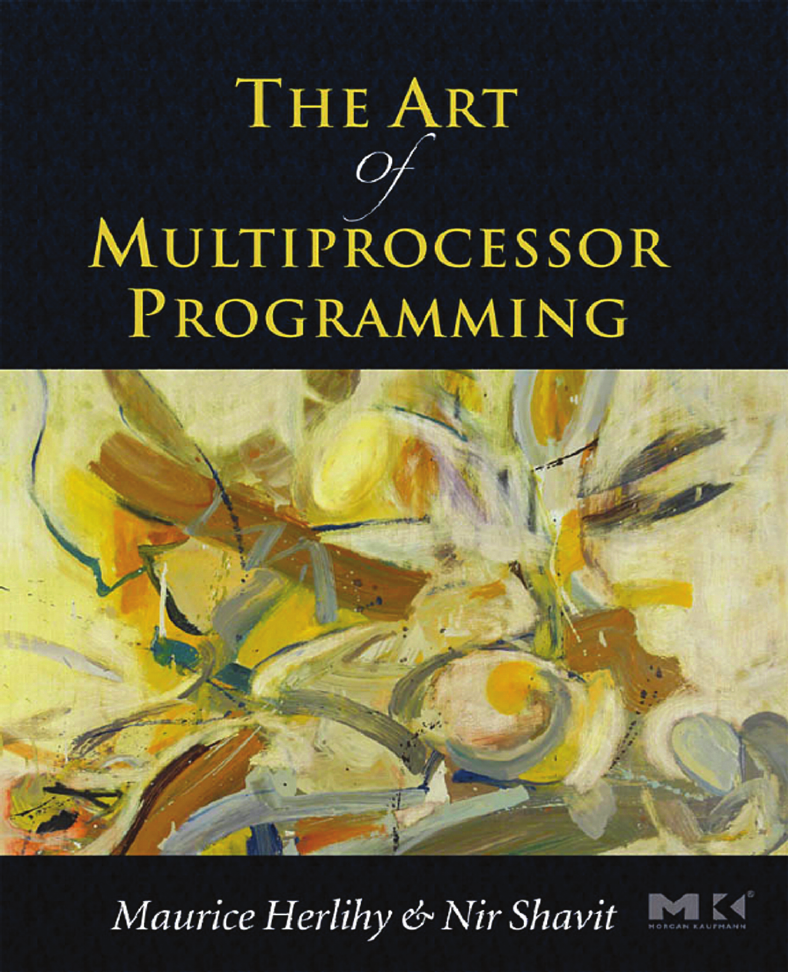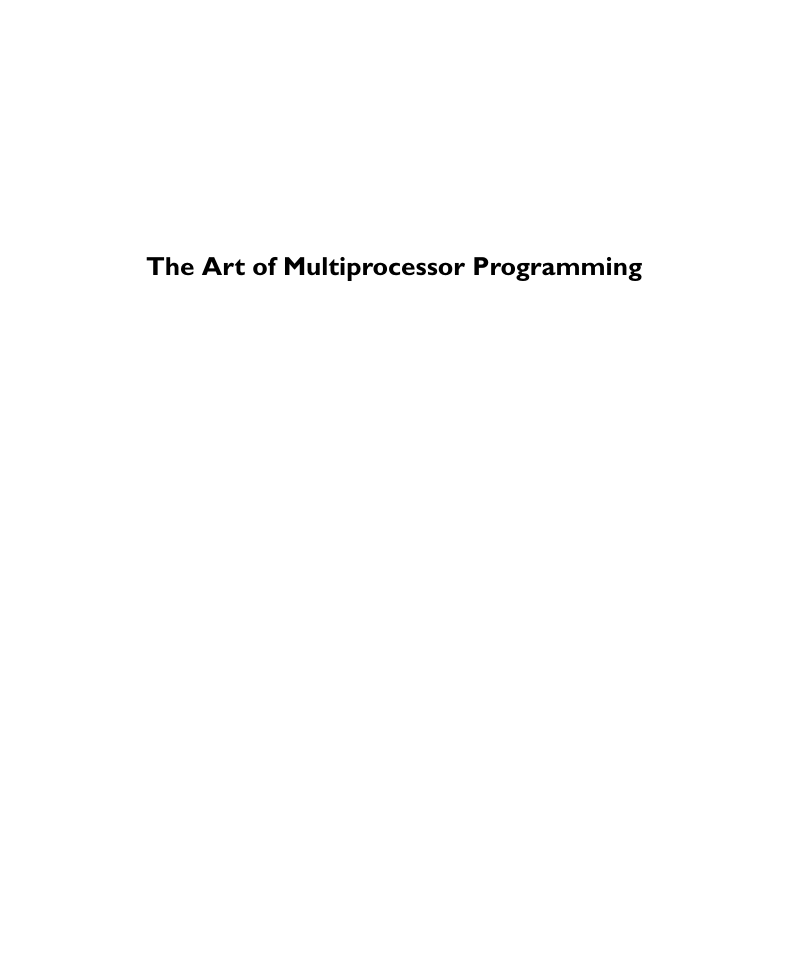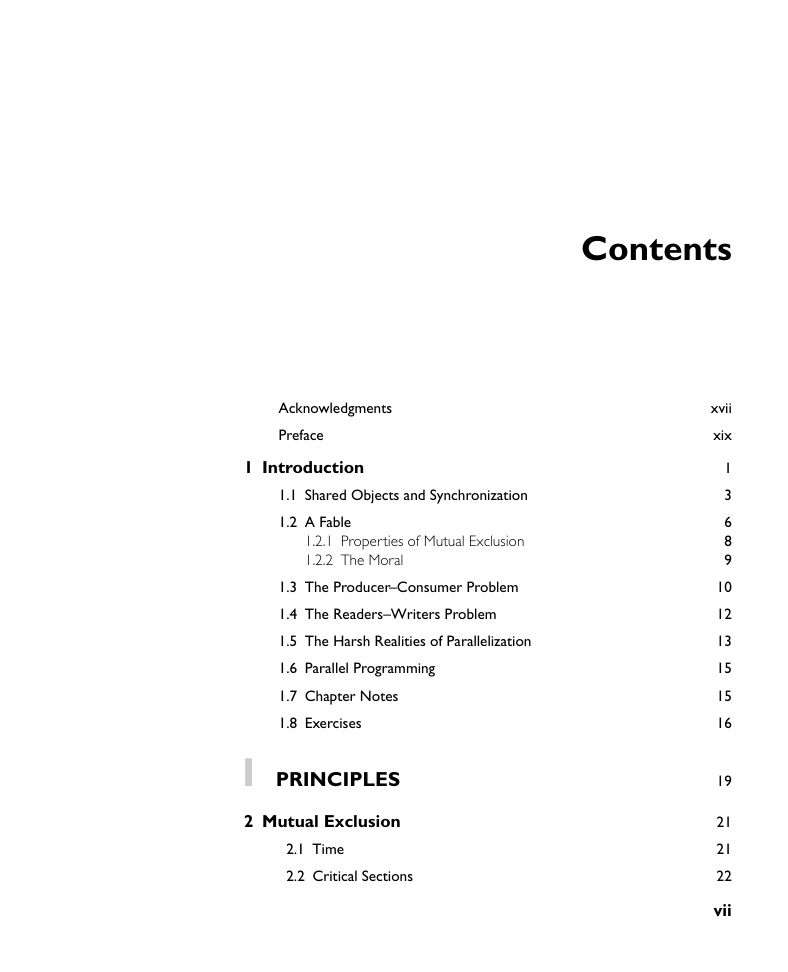The Art of Multiprocessor Programming
Copyright Page
Table of Contents
Acknowledgments
Preface
Chapter 1. Introduction
1.1 Shared Objects and Synchronization
1.2 A Fable
1.3 The Producer–Consumer Problem
1.4 The Readers–Writers Problem
1.5 The Harsh Realities of Parallelization
1.6 Parallel Programming
1.7 Chapter Notes
1.8 Exercises
Part I: Principles
Chapter 2. Mutual Exclusion
2.1 Time
2.2 Critical Sections
2.3 2-Thread Solutions
2.4 The Filter Lock
2.5 Fairness
2.6 Lamport’s Bakery Algorithm
2.7 Bounded Timestamps
2.8 Lower Bounds on the Number of Locations
2.9 Chapter Notes
2.10 Exercises
Chapter 3. Concurrent Objects
3.1 Concurrency and Correctness
3.2 Sequential Objects
3.3 Quiescent Consistency
3.4 Sequential Consistency
3.5 Linearizability
3.6 Formal Definitions
3.7 Progress Conditions
3.8 The Java Memory Model
3.9 Remarks
3.10 Chapter Notes
3.11 Exercises
Chapter 4. Foundations of Shared Memory
4.1 The Space of Registers
4.2 Register Constructions
4.3 Atomic Snapshots
4.4 Chapter Notes
4.5 Exercises
Chapter 5. The Relative Power of Primitive Synchronization Operations
5.1 Consensus Numbers
5.2 Atomic Registers
5.3 Consensus Protocols
5.4 FIFO Queues
5.5 Multiple Assignment Objects
5.6 Read–Modify–Write Operations
5.7 Common2 RMW Operations
5.8 The compareAndSet() Operation
5.9 Chapter Notes
5.10 Exercises
Chapter 6. Universality of Consensus
6.1 Introduction
6.2 Universality
6.3 A Lock-Free Universal Construction
6.4 A Wait-Free Universal Construction
6.5 Chapter Notes
6.6 Exercises
Part II: Practice
Chapter 7. Spin Locks and Contention
7.1 Welcome to the Real World
7.2 Test-And-Set Locks
7.3 TAS-Based Spin Locks Revisited
7.4 Exponential Backoff
7.5 Queue Locks
7.6 A Queue Lock with Timeouts
7.7 A Composite Lock
7.8 Hierarchical Locks
7.9 One Lock To Rule Them All
7.10 Chapter Notes
7.11 Exercises
Chapter 8. Monitors and Blocking Synchronization
8.1 Introduction
8.2 Monitor Locks and Conditions
8.3 Readers–Writers Locks
8.4 Our Own Reentrant Lock
8.5 Semaphores
8.6 Chapter Notes
8.7 Exercises
Chapter 9. Linked Lists: The Role of Locking
9.1 Introduction
9.2 List-Based Sets
9.3 Concurrent Reasoning
9.4 Coarse-Grained Synchronization
9.5 Fine-Grained Synchronization
9.6 Optimistic Synchronization
9.7 Lazy Synchronization
9.8 Non-Blocking Synchronization
9.9 Discussion
9.10 Chapter Notes
9.11 Exercises
Chapter 10. Concurrent Queues and the ABA Problem
10.1 Introduction
10.2 Queues
10.3 A Bounded Partial Queue
10.4 An Unbounded Total Queue
10.5 An Unbounded Lock-Free Queue
10.6 Memory Reclamation and the ABA Problem
10.7 Dual Data Structures
10.8 Chapter Notes
10.9 Exercises
Chapter 11. Concurrent Stacks and Elimination
11.1 Introduction
11.2 An Unbounded Lock-Free Stack
11.3 Elimination
11.4 The Elimination Backoff Stack
11.5 Chapter Notes
11.6 Exercises
Chapter 12. Counting, Sorting, and Distributed Coordination
12.1 Introduction
12.2 Shared Counting
12.3 Software Combining
12.4 Quiescently Consistent Pools and Counters
12.5 Counting Networks
12.6 Diffracting Trees
12.7 Parallel Sorting
12.8 Sorting Networks
12.9 Sample Sorting
12.10 Distributed Coordination
12.11 Chapter Notes
12.12 Exercises
Chapter 13. Concurrent Hashing and Natural Parallelism
13.1 Introduction
13.2 Closed-Address Hash Sets
13.3 A Lock-Free Hash Set
13.4 An Open-Addressed Hash Set
13.5 Chapter Notes
13.6 Exercises
Chapter 14. Skiplists and Balanced Search
14.1 Introduction
14.2 Sequential Skiplists
14.3 A Lock-Based Concurrent Skiplist
14.4 A Lock-Free Concurrent Skiplist
14.5 Concurrent Skiplists
14.6 Chapter Notes
14.7 Exercises
Chapter 15. Priority Queues
15.1 Introduction
15.2 An Array-Based Bounded Priority Queue
15.3 A Tree-Based Bounded Priority Queue
15.4 An Unbounded Heap-Based Priority Queue
15.5 A Skiplist-Based Unbounded Priority Queue
15.6 Chapter Notes
15.7 Exercises
Chapter 16. Futures, Scheduling, and Work Distribution
16.1 Introduction
16.2 Analyzing Parallelism
16.3 Realistic Multiprocessor Scheduling
16.4 Work Distribution
16.5 Work-Stealing Dequeues
16.6 Chapter Notes
16.7 Exercises
Chapter 17. Barriers
17.1 Introduction
17.2 Barrier Implementations
17.3 Sense-Reversing Barrier
17.4 Combining Tree Barrier
17.5 Static Tree Barrier
17.6 Termination Detecting Barriers
17.7 Chapter Notes
17.8 Exercises
Chapter 18. Transactional Memory
18.1 Introduction
18.2 Transactions and Atomicity
18.3 Software Transactional Memory
18.4 Hardware Transactional Memory
18.5 Chapter Notes
18.6 Exercises
Part III: Appendix
Appendix A. Software Basics
A.1 Introduction
A.2 Java
A.3 C#
A.4 Pthreads
A.5 Chapter Notes
Appendix B. Hardware Basics
B.1 Introduction (and a Puzzle)
B.2 Processors and Threads
B.3 Interconnect
B.4 Memory
B.5 Caches
B.6 Cache-Conscious Programming, or the Puzzle Solved
B.7 Multi-Core and Multi-Threaded Architectures
B.8 Hardware Synchronization Instructions
B.9 Chapter Notes
B.10 Exercises
Bibliography
Index
















 2023年江西萍乡中考道德与法治真题及答案.doc
2023年江西萍乡中考道德与法治真题及答案.doc 2012年重庆南川中考生物真题及答案.doc
2012年重庆南川中考生物真题及答案.doc 2013年江西师范大学地理学综合及文艺理论基础考研真题.doc
2013年江西师范大学地理学综合及文艺理论基础考研真题.doc 2020年四川甘孜小升初语文真题及答案I卷.doc
2020年四川甘孜小升初语文真题及答案I卷.doc 2020年注册岩土工程师专业基础考试真题及答案.doc
2020年注册岩土工程师专业基础考试真题及答案.doc 2023-2024学年福建省厦门市九年级上学期数学月考试题及答案.doc
2023-2024学年福建省厦门市九年级上学期数学月考试题及答案.doc 2021-2022学年辽宁省沈阳市大东区九年级上学期语文期末试题及答案.doc
2021-2022学年辽宁省沈阳市大东区九年级上学期语文期末试题及答案.doc 2022-2023学年北京东城区初三第一学期物理期末试卷及答案.doc
2022-2023学年北京东城区初三第一学期物理期末试卷及答案.doc 2018上半年江西教师资格初中地理学科知识与教学能力真题及答案.doc
2018上半年江西教师资格初中地理学科知识与教学能力真题及答案.doc 2012年河北国家公务员申论考试真题及答案-省级.doc
2012年河北国家公务员申论考试真题及答案-省级.doc 2020-2021学年江苏省扬州市江都区邵樊片九年级上学期数学第一次质量检测试题及答案.doc
2020-2021学年江苏省扬州市江都区邵樊片九年级上学期数学第一次质量检测试题及答案.doc 2022下半年黑龙江教师资格证中学综合素质真题及答案.doc
2022下半年黑龙江教师资格证中学综合素质真题及答案.doc